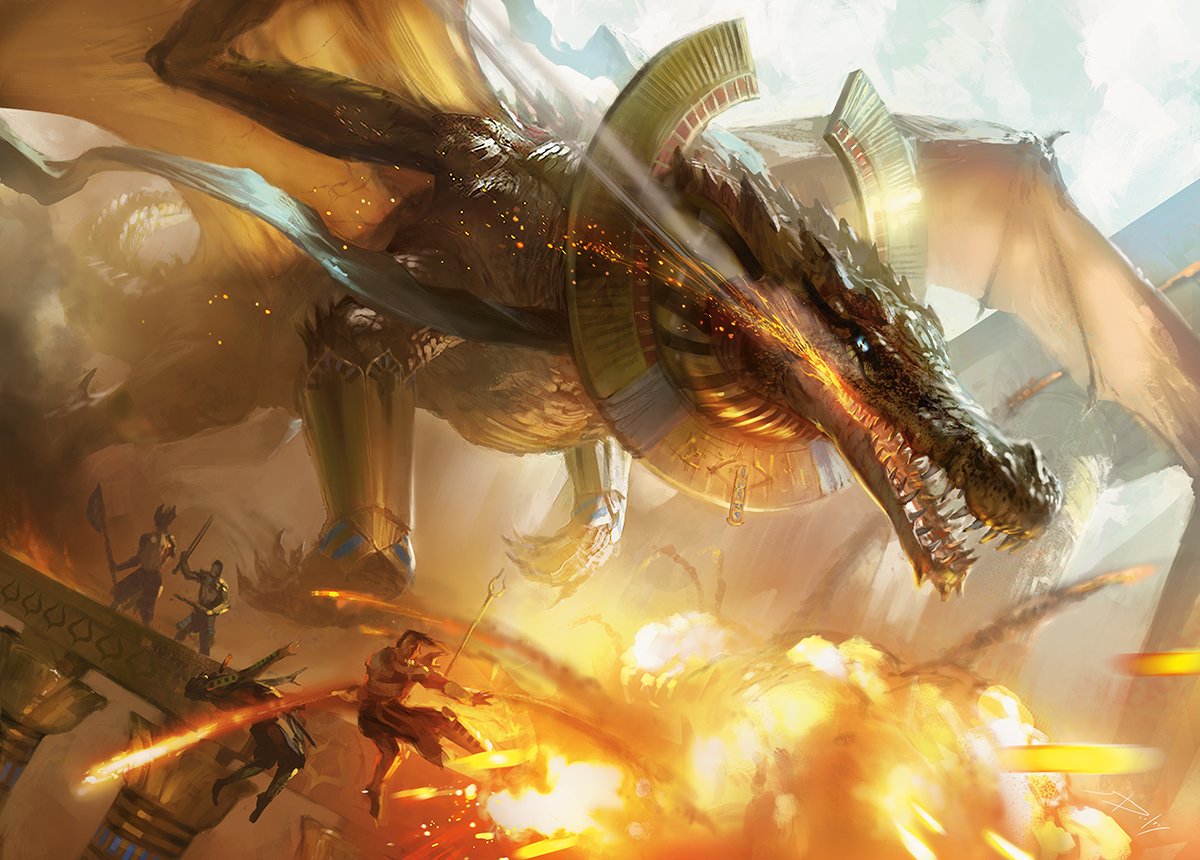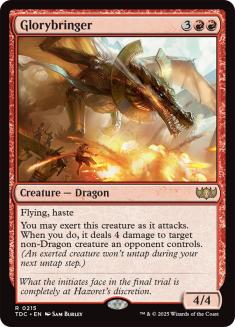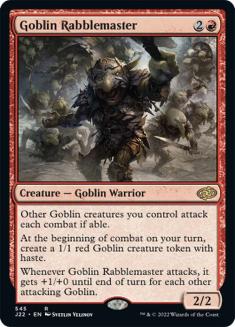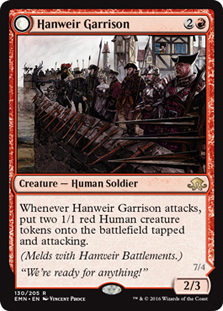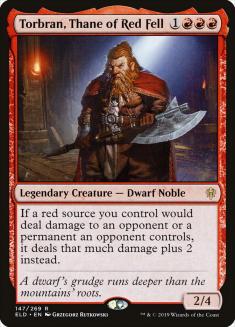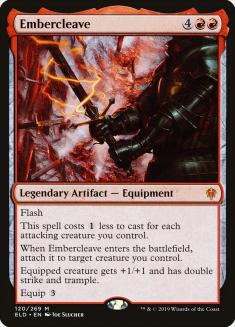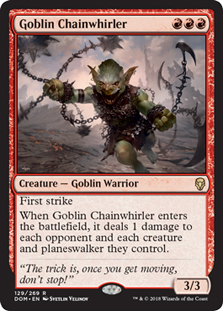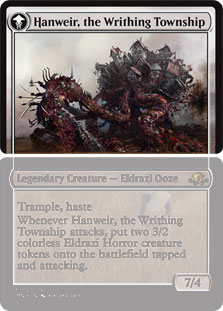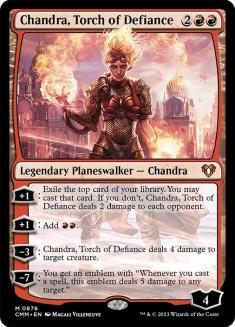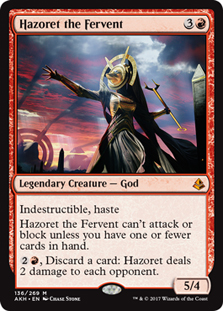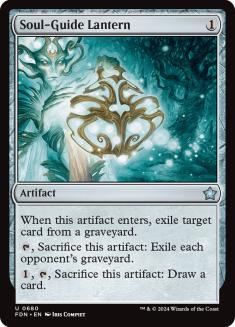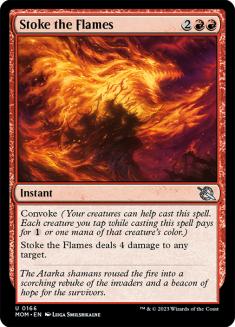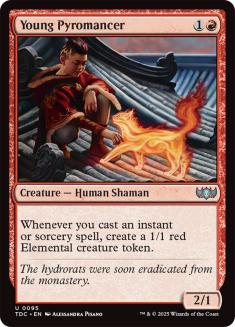Pioneer is pretty up in the air right now, but things are starting to take shape. We’ve seen Mono-Green Devotion come out as the frontrunner so far, putting up stellar numbers in the hands of some medium-time streamers. The consistency and power level are both out of control, but not in a way that isn’t manageable. The deck can lose, and does so regularly, but has one of the highest ceilings in the format.
Ways to combat small green creatures include: cheap removal, fast clocks, and ways to punish planeswalkers. Mono-Red Aggro in some shape or form has traditionally been the foil to any archetype playing Llanowar Elves. Something about using Shock as a virtual Stone Rain is pretty appealing in a world where everyone is trying to mana ramp with creatures.
The format is far from solved. I’m seeing a lot of different archetypes in every stream so far, with a few decks performing at or above expectation. There have been a few major events on Magic Online so far, which is providing the community with a lot of great starting points. In a format where everything is new and fresh, having these lists is invaluable. Using the information from these lists being published is important, because it might allow you to predict the shifts in the metagame.
For example, if I were to see Mono-Green Devotion all over the top of the most recent tournament, I would expect to see many more Goblin Chainwhirlers in the near future. That might put me off something like Lurrus of the Dream-Den because those decks usually falter against Goblin Chainwhirler. The shifting metagame in a format as open as Pioneer is hard to predict, but hitting the nail on the head will usually result in great reward.
But I’m not here to talk about Mono-Green Devotion. I did that last week, then D00mwake went and won the Magic Online Showcase with it. This week we’re going to be discussing a deck that I think has a decent matchup against Mono-Green Devotion — Grixis Control.
Just kidding. It’s time to get Chonky!
The Chonky Lyfe Chose Me
Being Chonky is a state of mind. People ask me all the time: What does it mean? Thick butts and hard cuts, Chonky Red is a deck unlike other red decks. Instead of the traditional approach to red, focusing hard on burn spells and small creatures, we instead do things a little bigger. To the heart of the matter, Chonky just means thicc, big, or maybe just larger than normal. Stop thinking Runaway Steam-Kin and start thinking Glorybringer.
It isn’t all that strange to see “Big Red,” the deck’s original name, be one of the better decks in Pioneer. It was hard-cut by the presence of so many combo decks, making the disruption that red had to offer somewhat lackluster. Red doesn’t really “interact” in the traditional sense. They aren’t countering spells or making you discard cards. Land destruction has all but gone the way of the dodo, so they’re left just trying to kill you. When Dimir Inverter became the “it girl” of Pioneer, decks like Chonky Red just couldn’t compete. We went from a format where Glorybringer was a peach of a card to a format where it was almost unplayable.
As a result, red went back to its aggressive roots, forming an alliance with the likes of Eidolon of the Great Revel — mutually assured destruction. No game can last longer than six turns before someone has to die. That was the contract Dimir Inverter offered, and it was the one Mono-Red Aggro and all burn variants accepted. Chonky Red got boxed out.
With the most recent bannings, Mono-Red Aggro has become…unnecessary. We can be more refined; cultured in our tastes. No longer must we accept the rule of law as dictated by combo. Instead, Red can choose to be Chonky.
Creatures (23)
- 4 Goblin Rabblemaster
- 3 Hanweir Garrison
- 2 Kari Zev, Skyship Raider
- 4 Glorybringer
- 4 Soul-Scar Mage
- 2 Rekindling Phoenix
- 4 Bonecrusher Giant
Planeswalkers (3)
Lands (26)
Spells (8)

This version is not my own, but one that has been running rampant on Magic Online for the last week. It’s success is in large part due to a shift toward smaller creatures. When Bonecrusher Giant is good, a deck like Chonky Red can flourish. My favorite part of Chonky Red, by far, is the customization potential. A wide range of playable three-drop creatures means you can build it however you want in whatever shape fits the current metagame.
I want to talk about this iteration a bit, but I’ll do more of a general outline before moving on to a few more experimental builds.
The token producers at three mana are great, but for wildly different reasons. Both provide you with an “army in a can,” a singular creature to use for attacking purposes while your removal mops up their small blockers. Against control decks, a single Goblin Rabblemaster can go the distance, and conveniently creates a hasty goblin to finish a Teferi, Time Raveler! The downside is that Goblin Rabblemaster gets hosed by most removal spells, up to and including all playable red removal. Three toughness was something I was desperate for when helping build the first iteration of Chonky Red. While Goblin Rabblemaster was great, having your three-drop survive a Stomp was imperative.
Hanweir Garrison was that three-drop creature at first. It dodged a lot of the generic red removal, but it also was relatively hard to kill with Fatal Push. Since it dodged, ducked, dived, dipped, and dodged a lot of traditional removal, it fit into the shell perfectly. It also didn’t hurt that we were just trying to meme with Hanweir Battlements as a colorless land for Thought-Knot Seer and got lucky discovering it’s natural pair as a playable creature.
These creatures are usually accompanied by Torbran, Thane of Red Fell or Embercleave, two cards noticeably absent from the current builds. I don’t really understand why, but I can only surmise that these creatures are good enough on their own without any extra help. While Torbran and Embercleave are both great with these two knuckleheads, it is imperative that all your cards function both separately and synergistically. Embercleave doesn’t exactly do that, and struggles to come down in a decent timeframe or with great targets too often. There is also very little combo running around, which is where Embercleave usually shines.
Torbran is another story entirely. By itself, it functions as a 4/4. With any help, it just obliterates any opponent where you get to untap. In some scenarios, it is the only card in all of Magic that can save you. Of these two, Torbran is the one I want to incorporate back into the strategy the most. I expect this iteration goes with Rekindling Phoenix instead of Torbran because of all the colorless lands, similar to the reason why Goblin Chainwhirler is also absent.
This absentee is one of the reasons I went back and started exploring the archetype again, but found it unnecessary. Mutavault is just too good and playing four copies requires some sacrifices. My gut has told me from the beginning that Goblin Chainwhirler, while powerful, is just too slow to do its job when you’re on the draw. Simultaneously, I think it is correct to use your removal on Elves in the first few turns, which makes Goblin Chainwhirler a bit weaker as the game progresses.
Then you play against some nonsense like Bolas’s Citadel and wonder how anyone could play a deck like that when Goblin Chainwhirler is a card that exists. Sometimes the threat of a thing is more important for the health of the format than the thing itself. If you ‘re smart, you can use that fear to your advantage, omitting it from your plan and reaping the benefits of people trying to dodge it. It’s the best of both worlds.
Is Goblin Chainwhirler better than Hanweir Garrison? Yes, obviously, but Mutavault is a bit better than the seventh Mountain. A healthy balance of castable creatures and lands with abilities is key in a midrange archetype like Chonky Red. Since we’re only a single color, we don’t have access to tools outside of red, which means cards that allow us to use all our mana are significantly better here than normal. I wouldn’t recommend playing Shambling Vents in Five-Color Niv, but they’re functioning on a similar wavelength with the Triome package.
Plus, Meld is tight.
In my humble opinion, Glorybringer is the reason to play this deck. It’s the reason to play any bigger red deck. It hits like a truck and takes a creature with it. Your opponents just can’t tap out when you have access to five mana if they control a creature with four or less toughness. The way the games play out in Pioneer, all players attempt to use all their mana each turn. That usually means they’re tapped on when you hit five mana. Outside of control strategies or removal-heavy midrange, you should be able to catch your opponent off guard with Glorybringer almost every time.
Before Dimir Inverter, Glorybringer was one of the best cards in Pioneer. Now that Inverter is gone, I’ve felt the power of Glorybringer coursing through my veins once again. It’s so incredibly good, but the downside is that you have to play enough lands to support it. Since you have to play so many lands, it is imperative that you choose lands that can be used like spells.
And that, my friends, is how deckbuilding “works.” A bunch of cards have different properties, including strengths and weaknesses. It is your duty to mitigate their exploits while maximizing their usefulness. On occasion, you sacrifice some amount of utility or consistency for power. At other times, you do the opposite because your deck gains so much ground when all your pieces start working together. Here, we’re sacrificing the power boost from Goblin Chainwhirler for consistency. In the future, it might be correct to swap those two, but I’m still very much against playing Goblin Chainwhirler at the moment.
I’ve been pretty happy with Rekindling Phoenix so far, including liking it more than Chandra, Torch of Defiance. In a highly aggressive metagame, Chandra is not at its best. The minus ability killing a creature is only as good as your ability to prevent the Chandra from dying on the following attack. After sideboard, depending on the sizing of your opponent’s creatures, protecting it could be really easy or really difficult. With stuff like Spirits running around as one of the top aggressive decks, it’s pretty difficult to keep it around.
My gut says Rekindling Phoenix is better for a few reasons, but the biggest is actually flying. Creatures with flying are pretty dope at the moment, as most creature decks are able to gum up the ground rather easily. For example, I don’t connect with Bonecrusher Giant very often. It gets chumped or traded with far too often for my taste, which means there are too many creatures running around in the dirt.
Rekindling Phoenix is also fairly sick right now because most of the removal is “kill” instead of “exile.” When it was in Standard, most of the removal was “exile” in order to fight The Scarab God, but Pioneer is not that same format. Dreadbore and Fatal Push are a bit more normal than Utter End, though all see a fair amount of play.
I don’t know if I can bring myself to cut Chandra from the deck. It’s so absurd against a wide variety of opponents, but it plays significantly better as the apex of your curve instead of the middle. Because Glorybringer is also hanging out at the top end, you’re left with a relatively high average casting cost compared to most red decks. That means you need to curve 1-5 a bit more than other red decks because you’re not double-spelling on turns where you need to.
I don’t know how to explain it other than planeswalkers are generally better when you can take a defensive stance. Decks like Chonky Red, and more specifically creatures like Goblin Rabblemaster, are not great at playing defense. That means protecting your Chandra is no easy task, and leveraging the advantage of an active planeswalker is not a guarantee.
If my testing keeps showing Chandra to be lackluster, I may end up cutting it, but the result would likely be playing three or four copies of Rekindling Phoenix maindeck with a few Chandras in the sideboard. It’s still very good, but it gums up your hand on occasion, and is relatively weak against aggro decks by conventional standards. It’s very good in an attrition heavy matchup where all your removal kills your opponent’s creatures, like the mirror, but it’s absolute garbage against the likes of Ensoul Artifact, Bolas’s Citadel, or Sram Auras. There are just too many small creatures for you to kill, and the lack of Goblin Chainwhirler really starts to show.
The sideboard is pretty weak. I found myself desperately wanting something like Grafdigger’s Cage instead of Soul-Guide Lantern, but the biggest surprise was how weak Hazoret the Fervent felt after playing it for a few leagues. In general, cards like Hazoret the Fervent are better when your curve is lower. By design, it functions well when you pair it with cheap spells because you’re able to get low on cards and unlock its combat. When your deck is chock full of awesome four and five mana spells, as well as an above average number of threes, it gets much harder to empty your hand and have it attack on curve.
Because of my affinity for Rekindling Phoenix, I’ll likely fill out on those before resorting to Hazoret the Fervent in this build of red. When you go bigger, Hazoret is just mediocre.
Nothin’ But The Chonk
Here are two versions that I want to try next.
Creatures (26)
- 4 Goblin Rabblemaster
- 2 Kari Zev, Skyship Raider
- 4 Glorybringer
- 4 Soul-Scar Mage
- 3 Rekindling Phoenix
- 3 Legion Warboss
- 4 Bonecrusher Giant
- 2 Torbran, Thane of Red Fell
Lands (26)
Spells (8)

Rekindling Phoenix is quite good here, boxing out Chandra, Torch of Defiance because of its standout performance in testing thus far. Alongside Glorybringer, that horrible goose is just keeps coming back again and again, no matter how many times it gets whacked. It’s obnoxious and hits hard and no one wants it around, except for me!
Torbran, Thane of Red Fell is a nice addition to the archetype, and one we’ve definitely seen before. It pairs perfectly with the token generators, allowing them to do a bit more burst damage on the turn you cast Torbran. They also punish your opponent for not killing the tokens that the Goblin Gang leave behind! It’s a little awkward sometimes when you draw two copies of Mutavault, but we’re only playing a pair and they’re quite absurd when they land.
Because we added Lava Coil to the sideboard, we can trim a Chandra’s Defeat, otherwise you’ll have far too many cards to sideboard in without anything really bad to side out in the mirrors or against a more aggressive iteration of red.
Now something a little more fun! This version isn’t exactly “Chonky,” but it’s been rolling around in my brain and I figured now was as good a time as ever to put something on paper for your viewing pleasure. Stoke’em if you gottem!
Creatures (24)
- 4 Young Pyromancer
- 4 Goblin Rabblemaster
- 4 Monastery Swiftspear
- 4 Soul-Scar Mage
- 2 Legion Warboss
- 4 Bonecrusher Giant
- 2 Torbran, Thane of Red Fell
Lands (22)
Spells (14)

This version of red focuses on the forgotten combination of Young Pyromancer and Stoke the Flames, two cards that defined an entire Standard format when paired together. Rabble Red, or Boss Sligh back in the day, is an archetype that focuses on punishment points when your opponent chooses to interact with your early creatures. If they kill Monastery Swiftspear, they might fold to Young Pyromancer. If they kill Young Pyromancer, your Goblin Gang can steamroll.
Stoke the Flames is a powerful effect that functions well alongside a large number of our cards. The burst damage from it for almost free means you get to kill some creatures you might not normally be able to handle. When combined with Torbran, the extra damage it deals can light people up. It’s also a great way to use your goblin tokens from Goblin Rabblemaster without sending them to their doom.
This version likely needs some serious tuning, but the core looks solid. We might have too many creatures or too many Shocks, but that’s just something you have to figure out from playing a few matches. Maybe we’ll want Runaway Steam-Kin or Light Up the Stage or something to help give us some burst turns, but I quite like the idea of Stoke the Flames with Torbran. Something about it just feels right, ya know?
My deep dive into Pioneer has only just begun, and I’ve barely scratched the surface on many of these archetypes. The banning of so many major players in Pioneer has shaken up the format and it still hasn’t settled after two weeks! I’ll be trying out more stuff on stream over the next few weeks to see if anything else clicks. We all know that 5-Color Niv and Mono-Green Devotion are sick, but I’m confident there’s a lot of unexplored territory left to discover. We can all be Pioneers of Pioneer, setting off on a voyage of discovery and exploration. It’s a new dawn, a new day, and I’m feeling Chonky.

